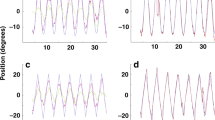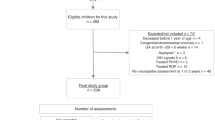Abstract
Recent research has demonstrated that a deficit of endogenous attention (EA) is a main and stable characteristic of the mental development in healthy extremely premature (HEP) infants from the age of 2 years. A study was made of the differences in EA (anticipatory attention) between full-term (FT) and HEP infants, both aged 5 months (the HEP infants’ ages were corrected for prematurity). The general psychomotor development of the HEP infants was comparable to that of the age-matched FT infants. However, the HEP infants significantly differed from the FT infants in the ability to keep the attention on an object absent in the visual field. Unlike the HEP infants, the FT infants demonstrated a predominance of EA over all other types of attention in the visual expectation paradigm, as confirmed by ANOVA with the factors Maturity and Attention Type. Comparison of the frequency of different types of attention between the two groups showed that the EA frequency in the HEP infants was significantly lower than that in the FT infants. The findings showed that HEP infants, even those with a low risk for abnormal psychomotor development, demonstrate the impairment of EA control as early as at the age of 5 months.
Similar content being viewed by others
REFERENCES
Msall, M.E. and Tremont, M.R., Functional Outcomes in Self-Care, Mobility, Communication, and Learning in Extremely Low-Birth Weight Infants, Clin. Perinatol., 2000, vol. 27, no.2, p. 38.
Hack, M., Klein, N.K., and Taylor, H.G., Long-Term Developmental Outcomes of Low Birth Weight Infants, Future Child., 1995, no. 5, p. 176.
Taylor, H.G., Klein, N., and Hack, M., School-Age Consequences of Birth Weight Less Than 750 g: A Review and Update, Dev. Neuropsychol., 2000, vol. 17, p. 289.
Fielder, A.R., Foreman, N, Moseley, M.J., and Robinson, J., Prematurity and Visual Development, Early Visual Development, Smians, K., Ed., New York: Oxford Univ. Press, 1993.
Bonin, M., Pomerleau, A., and Malcuit, G., A Longitudinal Study of Visual Attention and Psychomotor Development in Preterm and Full-Term Infants during the First Six Months of Life, Infant Behav. Dev., 1998, vol. 21, no.1, p. 103.
Johnson, M., The Development of Visual Attention: A Cognitive Neuroscience Perspective, The Cognitive Neurosciences, Gazzaniga, M.S., Ed., Cambridge: MIT, 1997, p. 735.
Posner, M.I. and Raichle, M.E., Images of Mind, New York: Sci. Am. Library, 1994.
Haith, M.M., Gratuity, Perception-Action, Integration, and Future Orientation, Contemporary Constructions in the Child: Essays in Honor of William Kessen, Kessel, F.S., Bornstein, M.H., and Sameroff, A.J., Eds., Hillsdale: Erlbaum, 1991, p. 23.
Haith, M.M., Hazan, C., and Goodman, G., Expectation and Anticipation of Dynamic Visual Events by 3.5-Month-Old Babies, Child. Dev., 1988, vol. 59, p. 467.
Gilmore, R.O. and Johnson, M.H., Working Memory in Infancy: Six-Month-Olds’ Performance on Two Versions of the Oculomotor Delayed Response Task, J. Exp. Child Psychol., 1995, vol. 59, p. 397.
Korner, A.F., Stevenson, D.K., Kraemer, H.C., et al., Prediction of the Development of Low Birth Weight Pre-term Infants by a New Neonatal Medical Index, J. Dev. Behav. Pediatr., 1993, vol. 14, no.2, p. 106.
Bayley, N., Bayley Scales of Infant Development, San Antonio: Psychological Corporation Harcourt Brace, 1993.
McGue, M., Thomas, J., and Bouchard, J., Adjustment of Twin Data for the Effects of Age and Sex, Behav. Genet., 1984, vol. 14, no.4, p. 325.
Lerns, W., Hopkins, B., and Samsom, J.F., Mental and Motor Development in Preterm Infants: The Issue of Corrected Age, Early Hum. Dev., 1993, vol. 34, p. 113.
Dreyfus-Brisac, C., Ontogenesis of Brain Bioelectrical Activity and Sleep Organization in Neonates and Infants, Human Growth, vol. 3, Falkner, F. and Tanner, J.M., Eds., London: Plenum, 1979, p. 157.
Ellingson, R.J. and Peters, J.F., Development of EEG and Daytime Sleep Patterns in Normal Full-Term Infants during the First Three Months of Life: Longitudinal Observation, EEG Clin. Neurophysiol., 190, vol. 50, p.165.
Gesell, A.L., Infancy and Human Growth, New York: Macmillan, 1928.
Colombo, J., On the Neural Mechanisms Underlying Developmental and Individual Differences in Visual Fixation in Infancy: Two Hypotheses, Dev. Rev., 1995, vol. 15, no.2, p. 97.
Sergienko, E.A., Antitsipatsiya v rannem ontogeneze cheloveka (Anticipation in Early Human Ontogenesis), Moscow: Nauka, 1992.
Munakata, Y., McClelland, J.L., Johnson, M.H., and Siegler, R.S., Rethinking Infant Knowledge: Towards an Adaptive Process Account of Successes and Failures in Object Permanence Tasks, Psychol. Rev., 1997, vol. 104, no.4, p. 686.
Ross, G., Tesman, J., Auld, P.A.M., and Nass, R., Effects of Subependymal and Mild Intraventricular Lesions on Visual Attention and Memory in Preterm Infants, Dev. Psychol., 1992, vol. 28, p. 1067.
Diamond, A., The Development and Neural Bases of Memory Functions as Indexed by the AB and Delayed Response Tasks in Human Infants and Infant Monkeys, Ann. New York Acad. Sci., 1990, vol. 608, p. 267.
Diamond, A., Recognition Memory Assessed by Looking Versus Reaching: Infants’ Performance on the Visual Paired Comparison and Delayed Non-Matching to Sample Tasks, in Technical Report IRCS-92-11, Univ. of Pennsylvania, Inst. for Research in Cognitive Science, 1992.
Espy, K.A., Stalets, M.M., McDiarmid, M.M., et al., Executive Functions in Preschool Children Born Pre-term: Application of Cognitive Neuroscience Paradigms, Child Neuropsychol., 2002, vol. 8, no.2, p. 83.
Luciana, M., Lindeke, L., Georgieff, M., et al., Neurobehavioral Evidence for Working-Memory Deficits in School-Aged Children with Histories of Prematurity, Dev. Med. Child Neurol., 1999, vol. 41, p. 521.
Chugani, H.T., Development of Regional Brain Glucose Metabolism in Relation to Behavior and Plasticity, Human Behavior and the Developing Brain, Dawson, G. and Fischer, K.W., Eds., New York: Guilford, 1994, p.153.
Conel, J.L., The Postnatal Development of the Human Cerebral Cortex, Cambridge, Mass.: Harvard Univ. Press, 1939–1967, vols. 1–8.
Vinogradova, O.S., Expression, Control, and Probable Functional Significance of the Neuronal θ Rhythm, Progr. Neurobiol., 1995, vol. 45, p. 523.
Squire, L.R. and Knowlton, B.J., Memory, Hippocampus, and Brain Systems, The Cognitive Neurosciences, Gazzaniga, M.S., Ed., Cambridge: MIT, 1997, p. 825.
Seress, L., Morphological Changes of the Human Hippocampal Formation from Mid Gestation to Early Childhood, Handbook of Developmental Cognitive Neuroscience, Nelson, Ch.A. and Luchiana, M., Eds., Cambridge, Mass.: Bradford, 2001, p. 79.
Isaacs, E.B., Lucas, A., Chong, W.K., et al., Hippocampal Volume and Everyday Memory in Children of Very Low Birth Weight, Pediatric Res., 2000, vol. 47, no.6, p. 713.
Allen, M.C., Outcome and Follow-Up of High Risk Infants, Avery’s Diseases of the Newborn, Taeusch, H. and Ballard, R., Eds., Philadelphia: Saunders, 1998, p. 413.
Resnick, M.B., Gomatam, S.V., Carter, R.L., et al., Educational Disabilities of Neonatal Intensive Care Graduates, Pediatrics, 1998, vol. 102, p. 308.
Author information
Authors and Affiliations
Additional information
__________
Translated from Fiziologiya Cheloveka, Vol. 31, No. 3, 2005, pp. 24–31.
Original Russian Text Copyright © 2005 by Stroganova, Posikera, Pisarevskii.
Rights and permissions
About this article
Cite this article
Stroganova, T.A., Posikera, I.N. & Pisarevskii, M.V. Endogenous Attention in 5-Month-Old Full-Term and Premature Infants. Hum Physiol 31, 262–268 (2005). https://doi.org/10.1007/s10747-005-0043-y
Received:
Issue Date:
DOI: https://doi.org/10.1007/s10747-005-0043-y




